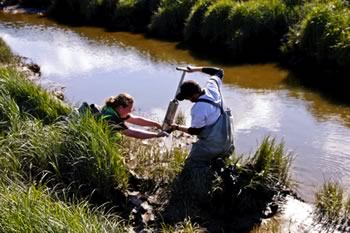Monitoring Methods
Invertebrates
Join the Discussion
Invertebrate Monitoring Methods

Invertebrates are important indicators of water quality and ecological integrity of marsh habitats (USEPA 2002). Additionally, invertebrate monitoring can be used to examine the availability of food resources for fish and avian predators. Fish consume a variety of prey items that fall into the water from the terrestrial environment, from within the water column, and from the benthos (Simenstad et al. 2001, Gray et al. 2002, and Ellings and Hodgson 2007), while waterbirds have a varied diet depending on the avian guild. In general, snow geese feed on emergent marsh vegetation, rhizomes and agricultural crop residue; shorebirds feed on benthic invertebrates; dabbling ducks feed on aquatic vegetation and invertebrates; and diving ducks feed on benthic invertebrates, aquatic invertebrates, and small fish (Weller and Fredrickson 1974, Kaminski and Prince 1981 and 1984, Takekawa et al. 2009). Although there is some spatial overlap of habitat use by fish and birds their peak use are temporally distinct. Because of high spatial and temporal variability within invertebrate fauna, the timing of invertebrate sampling should be closely aligned with the monitoring goals of the project (e.g. fall shorebird migration, Chinook outmigration season, etc.).
Typically, samples will be sent to a qualified invertebrate laboratory for sorting, identification, enumeration, and weighing for dry biomass. If you decide to sort and identify in-house, refer to the downloadable Invertebrate Lab Manual (USGS 2010).
Here we present information on collecting invertebrates from three different strata:
- Terrestrial insects (fall out traps)
- Pelagic invertebrates (neuston net)
- Benthic invertebrates (benthic invertebrate core)
References
Weller, M. W. and L. H. Fredrickson. 1974. Avian ecology of a managed glacial marsh. Living Bird 12:269-291.
